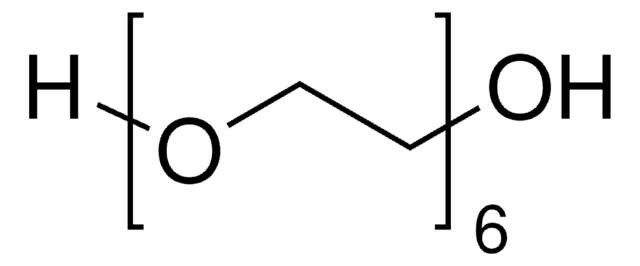About This Item
推荐产品
质量水平
方案
≥95% (oligomer purity)
表单
powder
分子量
average Mn 400
反应适用性
reaction type: click chemistry
reagent type: cross-linking reagent
Ω端
hydroxyl
α端
azide
官能团
azide
hydroxyl
储存温度
2-8°C
SMILES字符串
OCCOCCOCCOCCOCCOCCOCCOCCN=[N+]=[N-]
InChI
1S/C16H33N3O8/c17-19-18-1-3-21-5-7-23-9-11-25-13-15-27-16-14-26-12-10-24-8-6-22-4-2-20/h20H,1-16H2
InChI key
BUMODEBRFGPXRM-UHFFFAOYSA-N
应用
Some of the reported applications include:
- Synthesis of strain-stiffening hydrogels through self-assembly of oligomers fibres derived from Azido-PEG (n=7).
- Synthesis of biodegradable tetra-PEG hydrogels for drug delivery system.
- Synthesis of heterobifunctional oligo(ethylene glycol) linkers for bioconjugation and targeted drug delivery.
- Preparation of synthetic amphiphiles for programmed pH-dependent dispersions of carbon nanotubes (CNTs).
- Selective glycoprotein detection through allosteric click-imprinting by using a self-assembled monolayer developed from the above oligomer.
- Preparation of bioactivated quantum dot micelles containing fluorescent nanocrystals.
包装
警示用语:
Warning
危险声明
危险分类
Eye Irrit. 2 - Skin Irrit. 2 - STOT SE 3
靶器官
Respiratory system
储存分类代码
10 - Combustible liquids
WGK
WGK 3
闪点(°F)
Not applicable
闪点(°C)
Not applicable
个人防护装备
dust mask type N95 (US), Eyeshields, Gloves
法规信息
商品
Progress in biotechnology fields such as tissue engineering and drug delivery is accompanied by an increasing demand for diverse functional biomaterials. One class of biomaterials that has been the subject of intense research interest is hydrogels, because they closely mimic the natural environment of cells, both chemically and physically and therefore can be used as support to grow cells. This article specifically discusses poly(ethylene glycol) (PEG) hydrogels, which are good for biological applications because they do not generally elicit an immune response. PEGs offer a readily available, easy to modify polymer for widespread use in hydrogel fabrication, including 2D and 3D scaffold for tissue culture. The degradable linkages also enable a variety of applications for release of therapeutic agents.
Designing biomaterial scaffolds mimicking complex living tissue structures is crucial for tissue engineering and regenerative medicine advancements.
我们的科学家团队拥有各种研究领域经验,包括生命科学、材料科学、化学合成、色谱、分析及许多其他领域.
联系技术服务部门![2-[2-(2-氨基乙氧基)乙氧基]乙醇 溶液 ~0.5 M in tert-butyl methyl ether](/deepweb/assets/sigmaaldrich/product/structures/374/007/eea7ca74-41e4-4aac-af71-c93c37ec0a5a/640/eea7ca74-41e4-4aac-af71-c93c37ec0a5a.png)




![2-[2-(2-氯乙氧基)乙氧基]乙醇 96%](/deepweb/assets/sigmaaldrich/product/structures/902/295/ff6d7bb1-a7e0-4582-86e1-819084626e67/640/ff6d7bb1-a7e0-4582-86e1-819084626e67.png)




